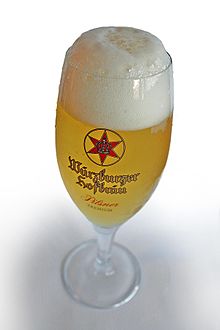Pale lager
| Pale lager | |
|---|---|

A typical pale lager – Würzburger Hofbräu
|
|
| Country of origin | Germany |
| Yeast type | Bottom-fermenting |
Pale lager is a very pale-to-golden-coloured lager beer with a well attenuated body and a varying degree of noble hop bitterness.
The brewing process for this beer developed in the mid-19th century when Gabriel Sedlmayr took pale ale brewing techniques back to the Spaten Brewery in Germany and applied them to existing lagering methods. This approach was picked up by other brewers, most notably Josef Groll of Bavaria who produced Pilsner Urquell in the city of Pilsen in the Austro-Hungarian Empire (now in the Czech Republic). The resulting Pilsner beers – pale-coloured, lean and stable beers – were very successful and gradually spread around the globe to become the most common form of beer consumed in the world today.
Bavarian brewers in the sixteenth century were required by law to brew beer only during the cooler months of the year. In order to have beer available during the hot summer months, beers would be stored (lagered) in caves and stone cellars, often under blocks of ice.
In the period 1820–1830, a brewer named Gabriel Sedlmayr II the Younger, whose family was running the Spaten Brewery in Bavaria, went around Europe to improve his brewing skills. When he returned, he used what he had learned to get a more stable and consistent lager beer. The Bavarian lager was still different from the widely known modern lager; due to the use of dark malts it was quite dark, representing what is now called Dunkel beer or the stronger variety, Bock beer.
The new recipe of the improved lager beer spread quickly over Europe. In particular Sedlmayr's friend Anton Dreher adopted new kilning techniques that enabled the use of lighter malts to improve the Viennese beer in 1840–1841, creating a rich amber-red coloured Vienna-style lager.
...
Wikipedia
